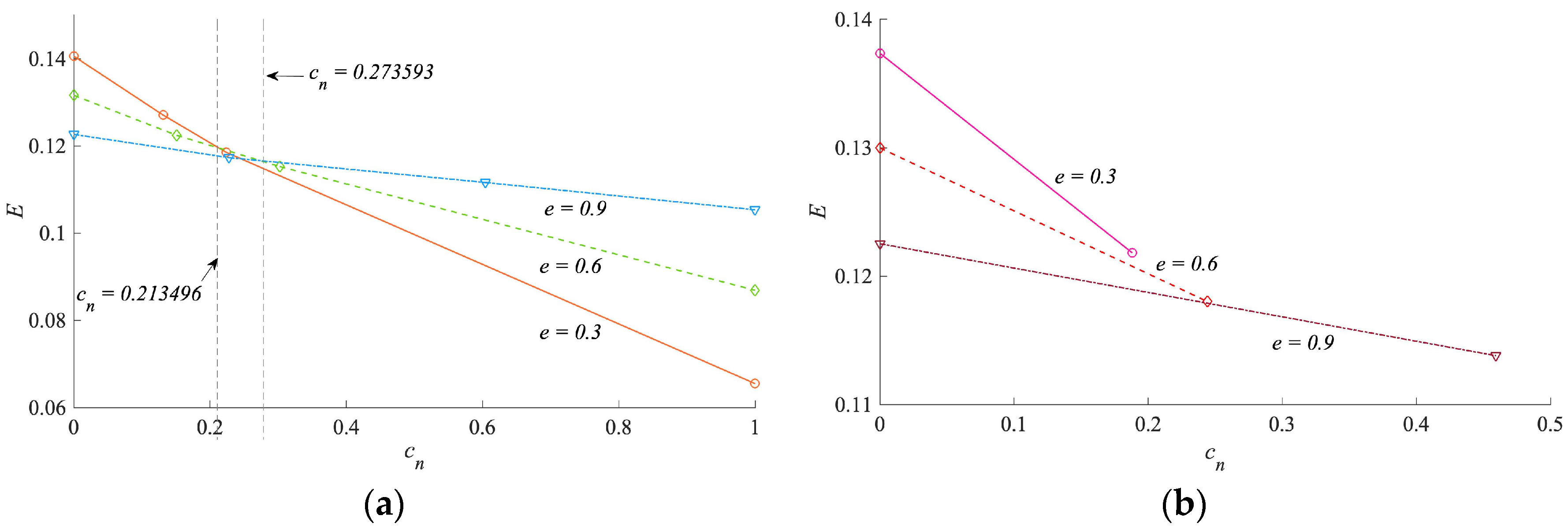Appendix A
Proof of Proposition 1. In the absence of take-back legislation, the Lagrangian function for the OEM’s problem (recall that in this scenario) is , where for represents the Lagrangian multipliers. Additionally, the KKT optimality conditions are , , , , and .□
Because the Lagrangian multipliers can be either non-negative or zero, we obtain eight cases in the absence of legislation (as shown in
Table A1). Furthermore, we do not consider strategy
because it is trivial, and we discard strategy
because the Lagrangian multiplier is less than zero. We also discard strategy
because
.
Table A1.
Cases of the Lagrangian multipliers in the absence of legislation.
Table A1.
Cases of the Lagrangian multipliers in the absence of legislation.
| Strategy | | | |
| | | |
| | | |
| | | |
| | | |
| | | |
| | | |
| | | |
| | | |
By solving all optimality conditions simultaneously in the remaining three cases, we obtain the following optimal strategies and their necessary conditions in the absence of legislation. The bound and its expression in all equilibrium strategies are shown in
Table A4 of
Appendix B.
Strategy . By solving the first-order conditions (FOCs), we obtain , , , and . leads to the necessary condition .
Strategy . By solving the FOCs, we obtain , , and . and lead to the necessary condition .
Strategy . By solving the FOCs, we obtain , , , and . leads to the necessary condition .
Proof of Proposition 2. Under take-back legislation with collection targets, the Lagrangian function for the OEM’s problem (recall that in this scenario) is , where for represents the Lagrangian multipliers. Additionally, the KKT optimality conditions are , , , , and .□
Table A2 describes the sixteen cases of Lagrangian multipliers under take-back legislation with collection targets. Moreover, we discard strategy
because it is trivial, strategy
because the Lagrangian multiplier is less than zero, and strategy
because
. In addition, strategy
is consistent with the no legislation scenario (Proposition 1). Because the three equilibrium strategies are not constrained by the collection target, we do not consider these redundant strategies.
Table A2.
Cases of the Lagrangian multipliers under take-back legislation with collection targets.
Table A2.
Cases of the Lagrangian multipliers under take-back legislation with collection targets.
| Strategy | | | | | Strategy | | | | |
| | | | | | | | | |
| | | | | | | | | |
| | | | | | | | | |
| | | | | | | | | |
| | | | | | | | | |
| | | | | | | | | |
| | | | | | | | | |
| | | | | | | | | |
By solving all optimality conditions simultaneously in the remaining three cases, we obtain the following optimal strategies and their necessary conditions under take-back legislation with collection targets.
Strategy . By solving the FOCs, we obtain , , , , and . leads to the necessary condition .
Strategy . By solving the FOCs, we obtain , , , and . , , and lead to the necessary condition .
Strategy . By solving the FOCs, we obtain , , , and . and lead to the necessary condition .
Proof of Corollary 1. Recall that, in Proposition 2, the OEM prefers the remanufacturing strategy if , and it forgoes the remanufacturing market if . Hence, we find the initial condition for and investigate the impact of and on the optimal strategy. In the optimal strategy , can be written as , where , and can also be written as , where .□
Proof of Proposition 3. Under take-back legislation with collection and reuse targets, the Lagrangian function for the OEM’s problem is , where for represents the Lagrangian multipliers. Additionally, the KKT optimality conditions are , , , , and .□
Table A3 describes the sixteen cases of Lagrangian multipliers under take-back legislation with collection and reuse targets. We discard strategy
because it is trivial, strategy
because the Lagrangian multiplier is less than zero, and strategy
because
. Furthermore, strategy
is consistent with the no legislation scenario (Proposition 1), strategy
is the same as take-back legislation with collection targets (Proposition 2), and we do not consider these redundant strategies. Finally, we also discard strategy
because it violates the actual situation, i.e.,
.
Table A3.
Cases of the Lagrangian multipliers under take-back legislation with collection and reuse targets.
Table A3.
Cases of the Lagrangian multipliers under take-back legislation with collection and reuse targets.
| Strategy | | | | | | Strategy | | | | | |
| | | | | | | | | | | |
| | | | | | | | | | | |
| | | | | | | | | | | |
| | | | | | | | | | | |
| | | | | | | | | | | |
| | | | | | | | | | | |
| | | | | | | | | | | |
| | | | | | | | | | | |
By solving all optimality conditions simultaneously in the remaining three cases, we obtain the following optimal strategies and their necessary conditions under take-back legislation with collection and reuse targets.
Strategy . By solving the FOCs, we obtain , , , , and . leads to the necessary condition .
Proof of Corollary 2. In the optimal strategy , can be written as , where , and can also be written as , where .□







